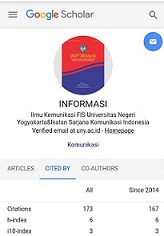AN INITIAL EXPLORATION ON TERRORISM ISSUES IN MALAYSIA AND INDONESIA: THE CASE OF THE WALL STREET JOURNAL
Sofia Hayati Yusoff, Departemen of Communication Universiti Sains Islam Malaysia, Malaysia
Siti Zobidah Omar, Universiti Putra Malaysia, Malaysia
Abstract
The symbiotic relationship between Islam and media is inevitable. The frequent of media coverage about Islam has been researched by many especially since the remarkable incident of September 11 in 2001. From that moment, Islam has been viewed and labelled as negative by the Western media specifically to the Muslims living in America and those in the Middle East countries. This phenomenon has been contagious to the Muslims in Southeast Asian countries such as Malaysia and Indonesia as these two countries are believed to have a connection with recent terrorist groups such as Islamic State of Iraq and the Levant (ISIL) and Islamic State in Iraq and Syria (ISIS). Therefore, this study was conducted to see the frequent coverage specifically on terrorism issues as reported by the Wall Street Journal (WSJ) and to explore the news themes that emerged in the news reporting. To realize this study, the researchers applied both quantitative and qualitative analysis to analyse the online news articles found in WSJ from year 2012 until 2013. The qualitative software was used in this study namely QSR Nvivo 11 to help and assist the researchers to store, manage and codify the news and also the quantitative software which is SPSS to calculate the frequencies of the reporting. The findings revealed that WSJ reported news related to terrorism in Malaysia and Indonesia frequently but it seems that Indonesia received higher percentage compared to Malaysia. In terms of news themes, the results found four major themes that are very much related to terrorism issues such as terrorist attacks, suspected as terrorist and robbery from both issues happened in Malaysia and Indonesia.
Keywords
Full Text:
PDFReferences
Ahmad, F. (2006). British Muslim perceptions and opinions on news coverage of September 11. Journal of Ethnic and Migration Studies, 32(6), 961-982. http://dx.doi.org/10.1080/13691830600761479.
Ali, S. (2008). US print media and portrayal of Muslim world: A study of Newsweek and Time (1991-2000) (Ph.D Dissertations, Bahauddin Zakariya University, Multan).
Allen, F. (2014). Islamophobia in the UK: The role of British newspapers in shaping attitudes towards Islam and Muslims. Retrieved from http://repository.uwtsd.ac.uk/413/1/Fleur%20Allen%20new.pdf.
Alshammari, D. (2013). Islamophobia. International Journal of Humanities and Social Science, 3(15), 177-180.
Asia Muslim Population. (2014). Retrieved from http://www.muslimpopulation.com/asia/.
Cassidy, R.M. (2008). Terrorism and insurgency. Parameters. 38, 129-140.
Creswell, J.W. (2012). Educational Research: Planning, Conducting and Evaluating Quantitative and Qualitative Research. Boston, MA: Pearson.
Dafrizal, Faridah Ibrahim, Chang Peng Kee & Fauziah Ahmad. (2013). Trend pemberitaan isu keganasan dalam akhbar perdana Malaysia dan Indonesia. Malaysian Journal of Communication, 29(2), 189-202.
Dafrizal Samsudin & Faridah Ibrahim (2010). Framing of ‘terrorism’ issues in Indonesia: A study of two Malaysian and Indonesian mainstream newspapers. Journal of Media and Information Warfare, 3,15-35.
Desker, B. (2002). Islam and society in South-East Asia after 11 September. Australian Journal of International Affairs, 56(3), 383-394, doi: 10.1080/1035771022000019714
Entman R. (1993). Framing: Toward clarification of a fractured paradigm. Journal of Communication, 43(4), 51–58. doi: 10.1111/j.1460-2466.1993.tb01304.x
Eliraz, G. (2004). Islam in Indonesia. Brighton: Sussex Academic Press.
Fauziah Hassan. (2017). News coverage on Islam and Muslims in Malaysia and Indonesia by Wall Street Journal and The Telegraph. (Ph.D Thesis, Universiti Putra Malaysia, Malaysia).
Faridah Ibrahim. (2008). Media Stereotyping: Reporting war and terorism. Journal Online, South-South Information Gateway (SSIG).
Faridah Ibrahim. (2003). Pengaruh pengurusan akhbar ke atas bilik berita. Dlm. Samsudin A. Rahim (pnyt). Kumpulan esei: Isu-isu komunikasi, hlm. 267-284. Bangi: Pusat Pengajian Media dan Komunikasi, Universiti Kebangsaan Malaysia.
Fealy, G., & Hooker, V. (2006). Voices of Islam in Southeast Asia: A Contemporary Sourcebook. Institute of Southeast Asian Studies (ISEAS), Singapore.
Fealy, G., Hooker, V., & White, S. (2006). Indonesia. In Fealy, G., & Hooker, V. (Eds), Voices of Islam in Southeast Asia. Pasir Panjang, Singapore: Institute of Southeast Asian Studies (ISEAS).
Funk, N. C., & Abdul Aziz, S. (2004). Islam and the west: Narratives of conflict and conflict transformation. International Journal of Peace Studies, 9 (1), 1-28. Retrieved from http://www.gmu.edu/programs/icar/ijps/vol9_1/Funk&Said_91IJPS.pdf.
Ghoshal, B. (2010). Arabization: The changing face of Islam in Asia. India Quarterly, 66(1), 69–89. doi: 10.1177/097492841006600105.
Hashim, F. Y. (2009). Islam dan terrorisme. Pemikir. 55, 49 – 66.
Hefner, R. W., & Horvatich, P. (1997). Islam in an era of Nation-States: Politics and Religious Renewal in Muslim Southeast Asia. USA: University of Hawai’i Press.
Houben, V. J. H. (2003). Southeast Asia and Islam. The ANNALS of the American Academy of Political and Social Science, 588(2003), 149-170, doi: 10.1177/0002716203588001010.
Isma Adila. (2011). Media dan Pemberitaan Terrorisme (Analisis Framing Pemberitaan Terrorisme di Indonesia pada Surat Kabar Kompas Edisi Tahun 2010. Retrieved from http://etd.repository.ugm.ac.id/index.php?mod=penelitian_detail&sub=PenelitianDetail&act=view&typ=html&buku_id=52813.
Isyaku Hassan, Mohd N. L. Azmi & Usman I. Abubakar. (2017). Framing Islam in News Reporting: A Comparative Content Analysis. Asian Social Science, 13(10), 112-119.
Ji Young Cho & Eun-Hee Lee. (2014). Reducing confusion about grounded theory and qualitative content analysis: Similarities and differences. The Qualitative Report, 19(64), 1-20. Retrieved from http://nsuworks.nova.edu/tqr/vol19/iss32/2/.
Kabir, N.S & Bourk, M. (2012). Representing Islam and Muslims in New Zealand newspapers. Journal of Muslim Minority Affairs, 32(3), 324–338. doi:10.1080/13602004.2012.727293
Kumala Citra Somara Sinaga. (2016). Analisis Framing Pemberitaan Bom Sarinah Di Kompas.Com Dan Merdeka.Com. JOM FISIP, 3(2), 1-12.
Laqueur, W. (2002). A history of terrorism. New Jersey: Transaction Publishers.
Mahony, I. (2010). Diverging frames: A comparison of Indonesian and Australian press portrayals of terrorism and Islamic groups in Indonesia. International Communication Gazette, 72(8), 739-758. doi: 10.1177/1748048510380813
Mc Quail, D. (1995) Media performance: Mass communication and the public interest. London: Sage.
Merriam, S. B. (2009). Qualitative research: A guide to design and implementation. San Francisco, CA: John Wiley and Sons, Inc.
Miller, E., & Daily, E. (2013). Understanding and measuring outcomes: the role of qualitative data. Institute for Research and Innovation in Social Services.
Neuman, W. L. (2014). Social research methods: Qualitative and quantitative approaches. USA: Pearson.
Neuman, L. W. (1997) Social research methods: Qualitative and quantitative approaches. Boston: Allyn & Bacon.
Noor Mayudia, M.M., Siti Hajar, A.A., & Shahril Anuar, A.G. (2010) The framing of Islamic- related world news by international news agencies in Malaysia in an English mainstream newspaper, The Star. In Mazni, B., Nur Kareelawati, A.K., Sofia Hayati, Y. & Suria Hani A.R (eds). Portrayal of Islam in the Media. Nilai: USIM.
Perreault, G. (2014). “Islam is everywhere”: Pre-Arab spring coverage of Islam in the English Egyptian press. Journal of Media and Religion, 13(2), 97–113. doi: 10.1080/15348423.2014.909207
Poole, E. & J.E. Richardson. (2006). Muslims and the news media. London: I. B Tauris.
Population Reference Bureau. (2014). Retrieved October 7, 2014, from www.prb.org.
Rane, H., & Ewart, M. (2012). the framing of Islam and Muslims in the tenth anniversary coverage of 9/11: implications for reconciliation and moving on. Journal of Muslim Minority Affairs, 32(3), 310-322. doi: 10.1080/13602004.2012.727292.
Macnamara, J. (2011). Media content analysis: its uses, benefits and best practice methodology. Asia Pacific Public Relations Journal, 6(1), 1-34. Retrieved from http://amecorg.com/wp-content/uploads/2011/10/Media-Content-Analysis-Paper.pdf.
Muhammad Raqib Mohd Sofian & Adnan Hussein. (2013). Media coverage on religious conflict in Malaysia: a preliminary study on how the star and Utusan Malaysia framed the attempts to subvert the faith and believe of Muslims in a multiracial thanksgiving dinner at DUMC. Procedia Social and Behavioral Sciences, 91(2013), 461-474. Doi: 10.1016/j.sbspro.2013.08.444
Nelson, S. A. D. (2006). News reporting on terrorism in Malaysia and Singapore. Media Asia, 33(3), 192-200.
Nelson, S. A. D. (2004). Southeast Asian press coverage of terrorism and the Bali bombing. The Copenhogen Journal of Asian Studies 20, 47-69.
Neuman, L.W. (2006). Social research methods: Qualitative and quantitative approaches. Boston: Pearson.
Patton, M. Q. (2001). Qualitative research and evaluation methods (2nd Edition). Thousand oaks, CA: Sage Publications.
Ridzuan Wu. (1990). The call to Islam: A contemporary perspective. Muslim Converts’ Association of Singapore.
Rose, S., Spinks, N., & Canhoto, A. I. (2015). Management research: Applying the principles (1st Ed). United Kingdom: Routledge.
Saodah Abd Rahman (2017, February 3). Fahami isu sensitif berkaitan agama. Utusan Online. Retrieved from http://www.utusan.com.my/rencana/fahami-isu-sensitif-berkaitan-agama-1.439691
Seale, C., & Tonkiss, F. (2012). Content and comparative keywords analysis. In Seale, C. Researching society and culture (3rd Ed). Los Angeles: Sage Publication.
Severin, W. J. & Tankard, J. W (2001). Communication theories: Origin, methods, and uses in the mass media (5th edition). New York: Longman.
Shafizan Mohammad, Mazni Buyong & Zeti Azreen (2014). From terrorist to Jihadist: A new portrayal of Muslims and Islam. Paper presented at Seminar Media and Da’wah, Universiti Sains Islam Malaysia (USIM).
Toeti Kakiailatu. (2007). Media in Indonesia: Forum for political change and critical assessment. Asia Pacific Viewpoint. 48(1), 60-71.
Wicaksono, Sigit (2017) Analisis bingkai pemberitaan tentang peristiwa bom Thamrin di Majalah Tempo dan Gatra. (Undergraduate thesis, Widya Mandala Catholic University Surabaya, Indonesia).
Wimmer, R.D. & Dominick, J.R. (2011). Mass media research: An introduction. Wadsworth, USA: Cengage Learning.
Zaharom Nain (2002). The structure of the media industry: Implications for democracy, in F. Loh & B. T Khoo (eds) Democracy in Malaysia: Discourses and practices, Richmond: Curzon.
Newspapers:
Utusan Malaysia, July, 25, 2009
Jakarta Post, July 31, 2009.
Wall Street Journal, August, 7, 2013
Wall Street Journal, October, 28, 2012
Wall Street Journal, June, 6, 2013
Wall Street Journal, December, 9, 2013 Wall Street Journal, July, 22, 2013
Wall Street Journal, May, 8, 2013 Wall Street Journal, October, 28, 2012
DOI: https://doi.org/10.21831/informasi.v48i1.19741
Refbacks
- There are currently no refbacks.
Copyright (c) 2018 Fauziah Hassan
Supervised by
Our Journal has been Indexed by:
Informasi by http://journal.uny.ac.id/index.php/informasi is licensed under a Creative Commons Attribution-NonCommercial 4.0 International License.














